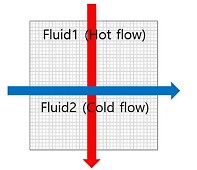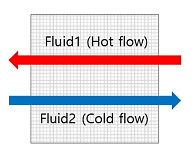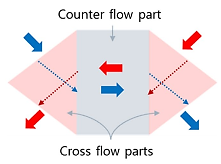Recuperator2
Bringing efficiency
to ...
Recuperators are air-to-air heat exchangers that, as their name suggests, use gas as the heat transfer medium on both sides. Their sole purpose is to recover wasted heat from process exhaust gases and utilize it to preheat incoming gases or air. These heat exchangers are typically constructed with finned surfaces.
TGT Company has designed and manufactured tubular recuperators as well as a new generation of plate recuperators, which utilize specially designed chevron-shaped plates to enhance heat transfer. Compared to finned recuperators, TGT plate recuperators offer a 30% higher heat transfer rate while being lighter in weight. Additionally, our tubular recuperators, featuring advanced engineering design and high-quality materials, serve as an ideal solution for improving energy efficiency and reducing operational costs across various industries.
Function
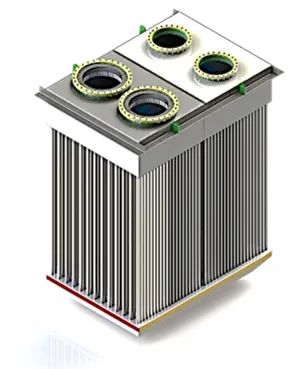
Different materials
for different applications.
One of the main factors that have a direct influence with the heat transfer rate is the selection of the plate’s material. The choice of materials for these components is crucial for optimal performance and longevity. By understanding the properties and applications of different materials, engineers can design heat exchangers that are optimized for specific process requirements.
Specifications
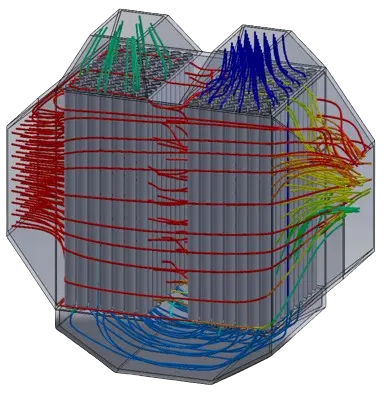
- Carbon Steel
- AISI 304/304L/304H
- AISI 321/321H
- AISI 316/316L/316H
- Type 316Ti
- AISI 310S/310H
- AISI 309S/309H
Materials
TGT, a leading manufacturer of heat exchangers, carries an extensive experience in designing wide range of heat exchangers for different industries. As been said, we know our customers’ lack of space will require us to use compact and adjustable heat exchangers so satisfying every need would be possible.
Each type of air-to-air heat exchanger is suited for specific applications, and their selection depends on factors such as temperature, pressure, environment, and energy requirements.
The different types of these exchangers based on their fluid flow are as follow:
Types of recuperators (based on flow)
In the recuperator manufactured by TGT Company, sheet metal forming has been used to create a pattern known as dimples, enhancing heat transfer efficiency. In other hand, foreign models typically utilize fins for heat transfer improvement.
A key consideration in this design is the optimization of the heat exchanger to achieve cost and material weight savings compared to finned models.
Plate type heat exchangers
The different types of these exchangers based on their means of heat transfer are as follow:
- Number of gas and air channels
- Spacing of plates on the gas and air sides
- Length, width, and depth of dimples
- Channel dimensions in terms of length and height
- Need for additional passes on the air side
The design parameters in this regard include:
Tubular recuperators utilize the principles of heat transfer and counterflow to efficiently transfer heat from one fluid to another. These recuperators consist of a series of tubes enclosed within a shell. The hot fluid enters the shell from one side, while the cold fluid flows through the tubes from the opposite side. This design allows heat to transfer through the tube walls to the cold fluid, enhancing thermal efficiency.
Tube type recuperator:
Design and innovation
TGT has optimized the geometry of its fully welded recuperators through extensive simulations. The unique chevron pattern employed in the plates represents a significant advancement in recuperator design. Other key features include:
- Exclusive use of laser cutting and up to 3 kW laser welding processes.
- Formation of heat transfer plates using the largest hydraulic press in the Middle East, manufactured by TGT.
Recuperators must be designed and manufactured according to international standards. Some of the important standards include the following:
- API Standard 662 Part 1 (ISO 15547-1)
- ASME BPVC Section VIII Division 1
- ASME B16.5 (Flanges)
- EN 13445 (Optional)
- EN 1092-1 (Optional Flanges)
- TEMA (Tubular Exchanger manufacturers Association)
Product Features
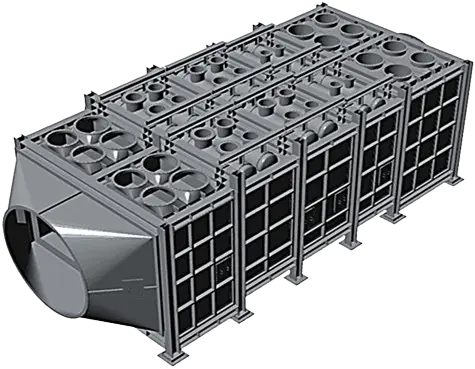
- Top Plate
- Middle Plate
- Column
- Lifting Log
- Divider
- Cell
- C Channel
Plate type recuperator Bill of Material:
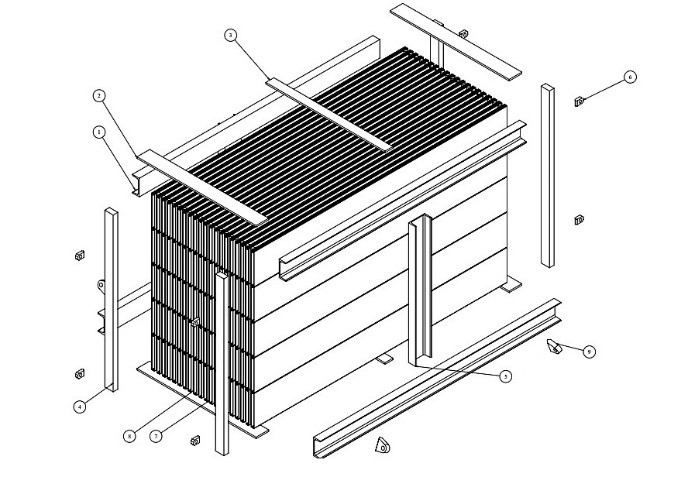
Tubes: The most important component of recuperators, which transfer heat from the hot fluid to the cold fluid.
Shell: The structure that encloses the tubes and allows the cold fluid to absorb heat from the walls of the tubes.
End Caps: Located at both ends of the recuperator, they control the entry and exit of fluids.
Insulation Walls: Used to prevent heat loss and improve the efficiency of the device.
Connections: Used to connect the tubes and various parts of the recuperator.
Tube type recuperator Bill of Material:
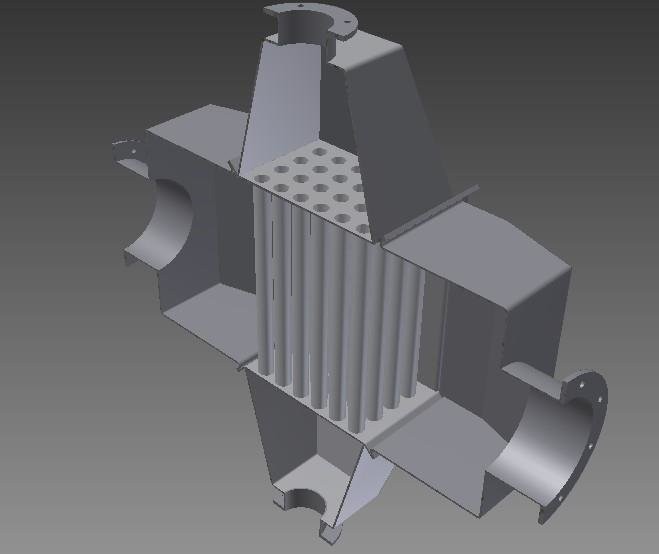
TGT air-to-air heat exchangers optimize both water and energy efficiency by heat exchanging between warm and cold air. During the process, steam in the warm air condenses, producing usable water, making these exchangers highly beneficial and economically viable for industries facing water and energy shortages.
Key advantages of recuperators include
- Energy Recovery: Air-to-air heat exchangers can recover waste heat from the system, leading to reduced energy consumption.
- Lower Operational Costs: By decreasing the energy required for heating or cooling, these exchangers help cut operating expenses.
- Easy Installation & Setup: Simple and convenient to install and operate.
- No Cross-Contamination: Since the two air streams remain completely separate, no contamination or direct material exchange occurs.
- High Efficiency & Performance: Particularly effective in conditions with a significant temperature difference between the two air streams.
Advantages
Overall, Air-to-Air heat exchangers have broad verity of applications in industries, which is indicated as below.
1-Automotive
2-Food
3-Chemical and petrochemical
Taha Ghaleb recuperators are designed with specially shaped chevron plates to enhance heat transfer efficiency. This unique design offers several advantages over conventional products. Among its benefits, these recuperators provide 30% higher heat transfer rates compared to finned models, while also featuring lower weight, reduced pressure drop, and decreased fouling tendency.
4-Oil and Gas
5-Steel manufacturing complexes
Recuperators are also used in the steel industry for preheating the air required in the direct reduction process of iron. This leads to significant energy savings and lower production costs.
6-HVAC industries
Applications
What makes us different?
Competitive Advantages
Design
Our products are designed, produced, and supplied across 8 main sites, and this feature provides a unique and strategic flexibility in meeting the industrial needs of the customers. The use of the most advanced and up-to-date equipment and machinery, along with a team of elite and experienced engineers, has enhanced both the quality and quantity of our products. All production equipment at TGT, such as heat exchangers, due to their high variety, must be designed and simulated using specialized software and tailored to specific working conditions. All of these products are designed and simulated with the help of specialized software developed by this knowledge-based company.
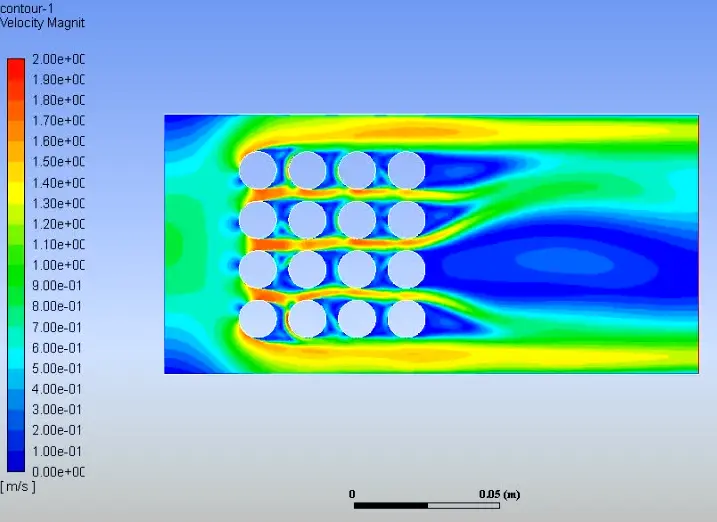
Manufacturing and quality:
TGT maintains complete control over the entire recuperators’ production cycle. From initial design to final assembly, all components are engineered in-house, ensuring optimal performance and customization. This comprehensive approach allows for precise tailoring of heat exchangers to specific process requirements.
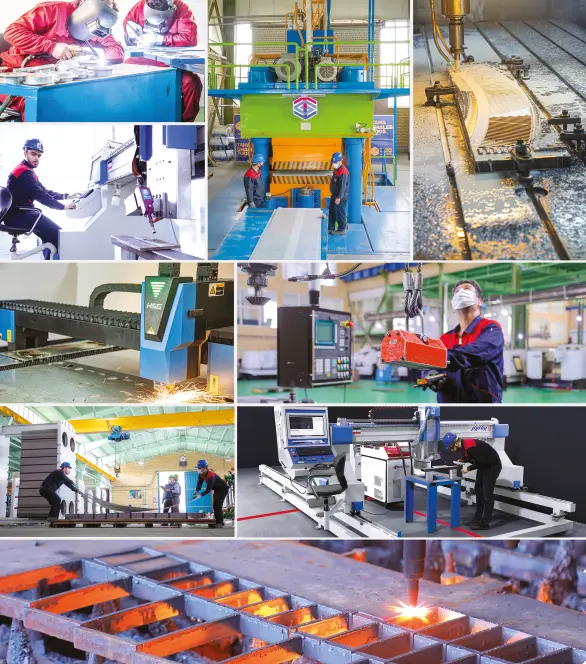
Strict quality control
TGT’s manufacturing process, from raw material sourcing to final assembly, is rigorously controlled by a dedicated quality assurance team. Every step, including plate forming, machining, painting, and Welding, is monitored to ensure adherence to the highest quality standards.
Key inspection techniques, such as Magnetic crack detection of welding, non-destructive penetrant spray inspection in welding, Ultra-sonic weld test and strict dimension inspection in plate manufacturing process are employed to meet global quality benchmarks.
Service (24/7)
The largest specialized heat exchanger repair center in the Middle East
TGT repair and maintenance service center is the largest specialized center for repairing heat exchangers in the country. Expert engineers can disassemble, repair, recondition and clean any heat exchanger devise on our service center sites. Technical experts initially check all parts of the heat exchanger based on any possible drafts provided by the customers. After the damaged parts are located, possible approaches are examined by the engineering team in order to repair the heat exchangers. At last, after taking the necessary approach for servicing the heat exchanger our technicians prepare the equipment for packing, and shipping to destination.
Successful Projects
TGT, relying on its technical knowledge, has succeeded in manufacturing recuperators in various types. One of the successful examples of these products is the recuperator for a petrochemical company, which, with its special design, receives the incoming hot fluid at a temperature of 300°C and, after heat transfer, discharges it from the exchanger at 214°C. This equipment, with a thermal capacity of 10.120 megawatts, plays an essential role in optimizing energy consumption and improving efficiency.
